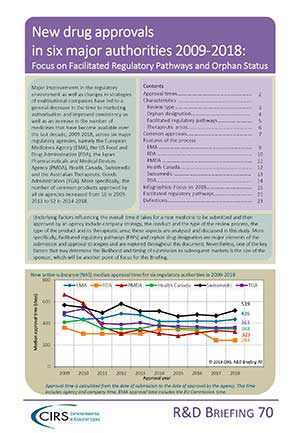Major improvements in the regulatory environment as well as changes in strategies of multinational companies have led to a general decrease in the time to marketing authorisation and improved consistency as well as an increase in the number of medicines that have become available over the last decade, 2009-2018, across six major regulatory agencies, namely the European Medicines Agency (EMA), the US Food and Drug Administration (FDA), the Japan Pharmaceuticals and Medical Devices Agency (PMDA), Health Canada, Swissmedic and the Australian Therapeutic Goods Administration (TGA). More specifically, the number of common products approved by all six agencies increased from 16 in 2009-2013 to 52 in 2014-2018.
Underlying factors influencing the overall time it takes for a new medicine to be submitted and then approved by an agency include company strategy, the conduct and the type of the review process, the type of the product and its therapeutic area; these aspects are analysed and discussed in this study. More specifically, facilitated regulatory pathways (FRPs) and orphan drug designation are major elements of the submission and approval strategies and are explored throughout this document. Nevertheless, one of the key factors that may determine the likelihood and timing of submission to subsequent markets is the size of the sponsor, which will be another point of focus for this Briefing.

